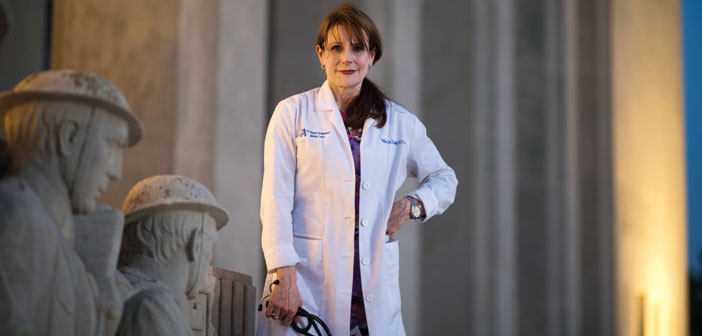Hollenbeck is 63, with long, auburn hair pulled into a ponytail that falls over her left shoulder. She’s 5 foot 3, gaining an inch or two in her ubiquitous heels. She’s fond of bright colors and bold patterns, fishnet tights, and lots of jewelry. She wears a stud in the cartilage of her right ear and gold bangles on her wrists, and the pendant of one of her necklaces is a 1930s Tiffany charm in the shape of a whistle—a gift from her husband, Richard Sun. Their cozy brick home, nestled in Jackson’s genteel Belhaven neighborhood, is around the corner from Eudora Welty’s house and several filming locations of The Help. It’s a world away from Canton, MA, where Hollenbeck grew up, but the lifelong Northerner settled in quickly. “I felt very at home right away,” she says, a touch of Mississippi taking the place of the Boston accent she lost long ago. “I tease, I must have been a Southern belle in a former life.”
She credits her “Irish humanity and sense of humor,” her Catholic underpinning, her supportive parents, and her Brown education for starting her down the path to outspoken veterans’ advocate. “She has a strong sense of morality, from her family, her religion, and her vows as a physician,” Sun says. “She could do the right thing or the wrong thing. … It was almost a non-choice.”
As a child, Hollenbeck dreamed of becoming a writer. But one human physiology class in high school and she was hooked. So, “I decided I wanted to be a doctor who writes.” At Brown she concentrated in literatures, choosing to take the full eight years to complete her degrees, rather than the accelerated AB/MD program, because “it was my last chance to write a thesis on George Eliot’s work,” she says.
After Commencement, Hollenbeck moved to upstate New York, to begin her residency in family medicine at St. Joseph’s Hospital in Syracuse. “Patient-centered care is now fashionable, a buzzword,” she says. “But that’s how I got trained.” She learned to ask questions and to listen and look for the answers, spoken and unspoken. She loved the “dance of connection” with her patients, and the “wonderful intellectual puzzle” of diagnosis and treatment. “You can’t be too lazy to ask questions,” she says. “Sometimes that one question is the only one that matters.” After residency, marriage, and a stint in the Public Health Service, Hollenbeck returned to Massachusetts to help care for her father, who had been diagnosed with prostate cancer. When he died, she opened a solo private practice and “got swamped.” She felt duty bound to her patients— “The last person of the day needs as much out of you as the first person of the day,” she says—but it was a brutal introduction to the real world of primary care: the long hours, the paperwork, the tight scheduling. After the birth of her second child she switched gears to become associate director of the family medicine residency at the University of Massachusetts Medical School, “which I loved immediately,” she says.
Sexism in medicine was a regular theme; she was the first or only woman to hold many of the posts on her CV. “I got spoiled at Brown,” where 20 of the 60 members of her class and some of the faculty were women, she says. “I got to residency and it was a shock.” In 1979, she was the first female family medicine resident delegate to the Annual Congress of the American Academy of Family Physicians (of which she is now a fellow). While running her practice she was the only woman on the local hospital staff; later, at a clinic in Worcester, MA, where she started their family medicine department, she was the only female department head. Attitudes were slow to change; a hospital president once informed her that he didn’t like married women who kept their last names. With three young children at home, she struggled to find work-life balance—a challenge, she laments, that continues for female physicians to this day.




